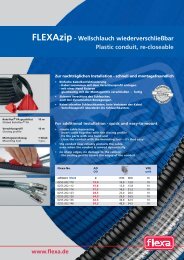Absauge- Abgas und Förderschläuche
Absauge- Abgas und Förderschläuche
Absauge- Abgas und Förderschläuche
Erfolgreiche ePaper selbst erstellen
Machen Sie aus Ihren PDF Publikationen ein blätterbares Flipbook mit unserer einzigartigen Google optimierten e-Paper Software.
Allgemeine Hinweise<br />
General Information<br />
Electrostatic charges in<br />
conveying and extraction plants<br />
1. When materials are conveyed<br />
through plastic tubing, an electrostatic<br />
charge arises because of the<br />
friction of the product conveyed<br />
against the tubing wall. At the<br />
same time, continuous charging<br />
processes take place between the<br />
individual particles when there is a<br />
flow of finely distributed materials.<br />
This applies in particular for<br />
chip and dust extraction plants, etc.<br />
Electrostatic charging is<br />
comparable with stored electrical<br />
energy, the so-called capacitor<br />
effect. The stored energy is<br />
released again on discharge, so<br />
that at a sufficient charge density,<br />
sudden discharge can take place.<br />
The discharge can also be<br />
triggered by contact of charged<br />
particles to earthed objects. Here<br />
the discharge can have the<br />
following effects:<br />
a)Interference with electronic<br />
components and thus faulty<br />
operation of machines and<br />
systems.<br />
b)Heat can be generated by the<br />
discharge leading in the<br />
presence of combustible gases<br />
or vapours to increased risk of<br />
ignition and explosion.<br />
Objects made from conductive<br />
materials whose leakage resistance<br />
is not greater than 10 6 ohms are<br />
considered to be electrostatically<br />
earthed.<br />
2. A differentiated assessment of<br />
ignition risks as well as of the<br />
protective measures to be taken<br />
requires accurate knowledge of<br />
the materials and processes<br />
involved as well as taking into<br />
account the relevant regulations<br />
and must therefore be made<br />
separately from case to case.<br />
When conveying and extraction<br />
tubing with supporting helix is<br />
used, not only parts of the conveyed<br />
product being deposited or<br />
clogging of the tubing can be<br />
largely decreased but the risk of<br />
ignition can be reduced by<br />
earthing the supporting helix.<br />
The specific resistance of the<br />
tubing material can be reduced by<br />
the incorporation of conductive<br />
pigments so that plastic with a<br />
leakage resistance of no more<br />
than 10 6 ohms can be used.<br />
3.These statements are to be viewed<br />
only as for guidance. It is therefore<br />
advisable to assess conveying<br />
and extraction tubing <strong>und</strong>er the<br />
local conditions of use and their<br />
application.<br />
Instructions for Application<br />
Spirally rolled metal hoses to be<br />
used as suction, blower and silo<br />
hoses<br />
When using spirally rolled metal<br />
hoses with polygonal cross section<br />
with engaged angular profile and<br />
without sealing, leakage must be<br />
expected. No leakage is admissible if<br />
the flow medium is dangerous to<br />
health or explosive.<br />
Spirally rolled metal hoses are particularly<br />
produced for suction conveying<br />
and can be used for pressure<br />
conveying with slight overpressure<br />
only.<br />
Waste Gas Metal Hoses with<br />
sealing free of harmless<br />
substance<br />
In many cases environmental protection<br />
requires compromises concerning<br />
the use of e. g. substitutes<br />
free of harmless substance. Concerning<br />
the substitution for asbestos,<br />
there is presently no material<br />
matching the positive characteristics<br />
of asbestos, in view of the mechanical-dynamical<br />
stress, especially in<br />
application as metal hose sealing.<br />
The glas fibre sealing is an alternative<br />
of harmless substance with the<br />
limiting characteristic that the<br />
duration of life of the dynamically<br />
strained metal hose sealing is<br />
substantially reduced. At the same<br />
time a higher leakage rate must be<br />
expected due to the fact that the<br />
brittle material is expanding faster<br />
than asbestos.<br />
1.15




